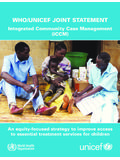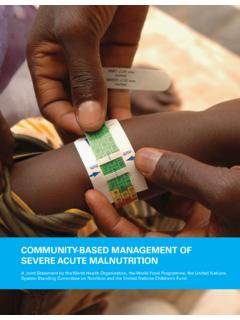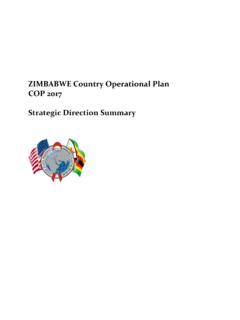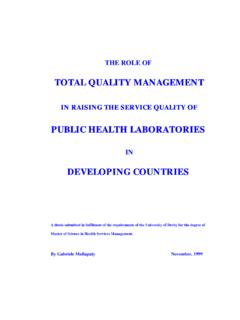Transcription of Preventing and controlling micronutrient deficiencies in ...
1 BackgroundDeficiencies of micronutrients are a major global health problem. More than 2 billion people in the world today are estimated to be deficient in key vitamins and miner-als, particularly vitamin A, iodine, iron and zinc. Most of these people live in low income countries and are typically deficient in more than one micronutrient . deficiencies oc-cur when people do not have access to micronutrient -rich foods such as fruit, vegetables, animal products and forti-fied foods, usually because they are too expensive to buy or are locally unavailable. micronutrient deficiencies increase the general risk of infectious illness and of dying from diar-rhoea, measles, malaria and pneumonia. These conditions are among the 10 leading causes of disease in the world today (1). The groups most vulnerable to micronutrient deficien-cies are pregnant women, lactating women and young chil-dren, mainly because they have a relatively greater need for vitamins and minerals and are more susceptible to the harmful consequences of deficiencies .
2 For a pregnant wom-an these include a greater risk of dying during childbirth, or of giving birth to an underweight or mentally-impaired baby. For a lactating mother, her micronutrient status determines the health and development of her breast-fed infant, especially during the first 6 months of life. For a young child, micronutrient deficiencies increase the risk of dying due to infectious disease and contribute to impaired physical and mental in eMergenciesMicronutrient deficiencies can easily develop during an emergency or be made worse if they are already present. This happens because livelihoods and food crops are lost; food supplies are interrupted; diarrhoeal diseases break out, resulting in malabsorption and nutrient losses; and infectious diseases suppress the appetite whilst increas-ing the need for micronutrients to help fight illness.
3 For these reasons it is essential to ensure that the micronutri-ent needs of people affected by a disaster are adequately met. For this to happen it is critical that general food-aid rations are adequate and well balanced to meet nutrient needs, and that they are distributed regularly and in suf-ficient quantities. One way to meet the recommended daily intake of micronutrients is to provide foods fortified with micro-nutrients (2 3). Fortified foods, such as corn-soya blend, biscuits, vegetable oil enriched with vitamin A, and iodized salt, are usually provided as part of food rations during emergencies. The aim is to avert micronutrient deficiencies or prevent them from getting worse among the affected population (4). Such foods must be appropriately fortified, taking into account the fact that other unfortified foods will meet a share of micronutrient needs.
4 However, foods fortified with micronutrients may not meet fully the needs of certain nutritionally vulnerable subgroups such as pregnant and lactating women, or young children. For this reason UNICEF and the WHO have devel-oped the daily multiple micronutrient formula shown in Table 1 to meet the recommended nutrient intake1 (RNI) of these vulnerable groups during emergencies (2, 3, 5). Joint statement by the World Health organization, the World Food Programme and the united nations children s FundPreventing and controlling micronutrient deficienciesin populations affected by an emergency Multiple vitamin and mineral supplements for pregnant and lactating women, and for children aged 6 to 59 monthsWorld Food ProgrammePierre VirotTable 1. The composition of multiple micronutrient supplements for pregnant women, lactating women, and children from 6 to 59 months of age, designed to provide the daily recommended intake of each nutrient (one RNI)Micronutrients Pregnant Children womena (6 59 months)aVitamin A g D g Vitamin E mg C mg (vitamin B1) mg (vitamin B2) mg (vitamin B3) mg B6 mg B12 g acid g mg mg mg g g See ref.
5 3; b see ref. 5; c see ref. 13; d See ref. 14 Pregnant and lactating women should be given this supple-ment providing one RNI of micronutrients daily, whether they receive fortified rations or not. Iron and folic acid supplements, when already provided, should be continued. When fortified rations are not being given, children aged 6 to 59 months should be given one dose each day of the micronutrient supplement shown in Table 1; when forti-fied rations are being given, children aged 6 to 59 months should be given two doses each week of the micronutrient supplement shown in Table 1. This schedule is shown in Table , vitamin A supplements should continue to be given to young children and mothers post-partum according to existing recommendations. Breastfeeding and appropriate complementary feeding should also continue to be promoted multiple micronutrient supplements should be given until the emergency is over and access to nutrient rich foods is restored.
6 At this time the micronutrient status of the population should be assessed to decide whether further interventions to prevent and control micronutrient deficiencies are multiple micronutrient supplement formulae are currently available from UNICEF, one for pregnant and lactating women (2) and one for children aged from 6 to 59 months (15). The micronutrient composition of these formulae correspond to approximately one RNI for each nutrient and therefore are similar to those presented in Tables 1a and 1b. Table 2. Schedule for giving the multiple micronutrient supplement shown in Table 1 which provides a daily recommended nutrient intake (1 RNI) Target Fortified food rations Fortified food groups are NOT being used rations are being usedPregnant and 1 RNI each day 1 RNI each day lactating women Children 1 RNI each day 2 RNI each week (6 59 months) MonitoringThe delivery of supplements should be monitored to assess coverage while existing micronutrient programmes should continue as before emergency (6).
7 The health of target groups should be monitored to ensure that they are protected from deficiencies as well as from excessive consumption. Indicators for this are described in several WHO publications (7 12).Moreover the continued need for supplements and forti-fied foods should be assessed periodically during and after the emergency. As the crisis wanes, the general distribu-tion of supplement is likely to be reduced and then increas-ingly targeted to specific groups. 1 Recommended nutrient intake is defined (RNI) as the daily dietary in-take of a nutrient sufficient to meet the nutrient requirements of nearly all apparently healthy individuals in a specific population group, usually by age and sex (9). The definition of the RNI is equivalent to that of recommended dietary allowance (RDA) used by the Food and Nutrition Board of the United Sates Institute of Medicine (10)reFerences1. The World Health Report 2001: Reducing risks, promoting healthy life.
8 Geneva, World Health Organization, UNICEF/UNU/WHO. Composition of a multi- micronutrient supplement to be used in pilot programmes among pregnant women in developing countries. Report of a Workshop. New York, UNICEF, FAO/WHO. Vitamin and mineral requirements in human nutrition, 2nd ed. Geneva, World Health Organization, 2005. 4. WFP. Nutrition in Emergencies WFP Experiences and challenges and micronutrient fortification: WFP experiences and ways forward. WFP Policy papers May Institute of Medicine. Food and Nutrition Board Dietary reference in-takes. Application in dietary assessment. A report of the Subcommittee on Interpretation and uses of dietary reference intakes and the Standing Com-mittee on the Scientific Evaluation of Dietary Reference Intakes. National Academic Press, Washington , 2001. 6. WHO/MI. Safe vitamin A dosage during pregnancy and lactation.
9 Recom-mendations and report of a consultation. Geneva, World Health Organiza-tion, 1998. (WHO/ ).7. Indicators for assessing vitamin A deficiency and their application in monitoring and evaluating intervention programmes. Geneva, World Health Organization, 1996 (WHO/ ).8. WHO/UNHCR. Pellagra and its prevention and control in emergencies. Geneva, World Health Organization, 1999 (WHO/ ).9. WHO/UNHCR. Scurvy and its prevention and control in emergencies. Ge-neva, World Health Organization, 1999 (WHO/ ).10. WHO/UNHCR. Thiamine deficiency and its prevention and control in major emergencies. Geneva, World Health Organization, 1999 (WHO/ ).11. WHO/UNICEF/ICCIDD. Assessment of iodine deficiency disorders and monitoring their elimination. 2nd ed. Geneva, World Health Organiza-tion, 2001 (WHO/ ).12. WHO/UNU/UNICEF. Iron deficiency anaemia. Assessment, prevention and control.
10 A guide for programme managers. Geneva, World Health Organi-zation, 2001 (WHO/ ).13. FAO/IAEA/WHO: Trace elements in human nutrition and health. WHO. Geneva. 1996 14. WHO. Prevention and control of iodine deficiency in pregnant and lactating women, and in children less than two years old. Report of a consultation. Geneva. (In press).acknoWledgeMentsThe following individuals contributed to the statement: Martin Bloem, Andr Briend, Bruno de Benoist, Nita Dalmiya, Ian Darnton Hill, Rainer Gross, Andrew Hall, Alessandro Loretti, Erin Mclean, Tina Van den Briel, Zita Weise Prinzo, Jelka Zupan. For FurtHer inForMation, Please contact:Dr Bruno de BenoistNutrition for Health and Development (NHD)World Health Organizatione-mail: home page.

















